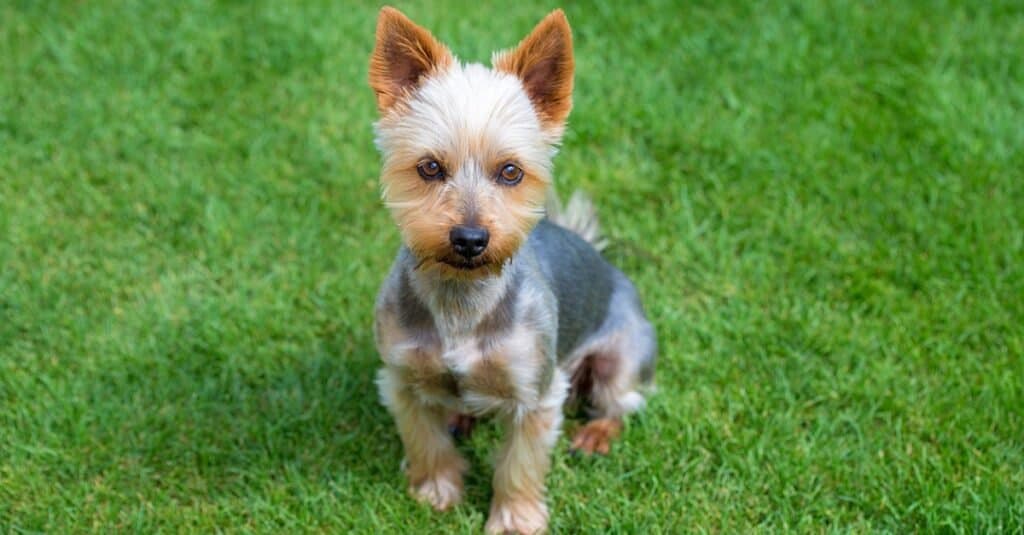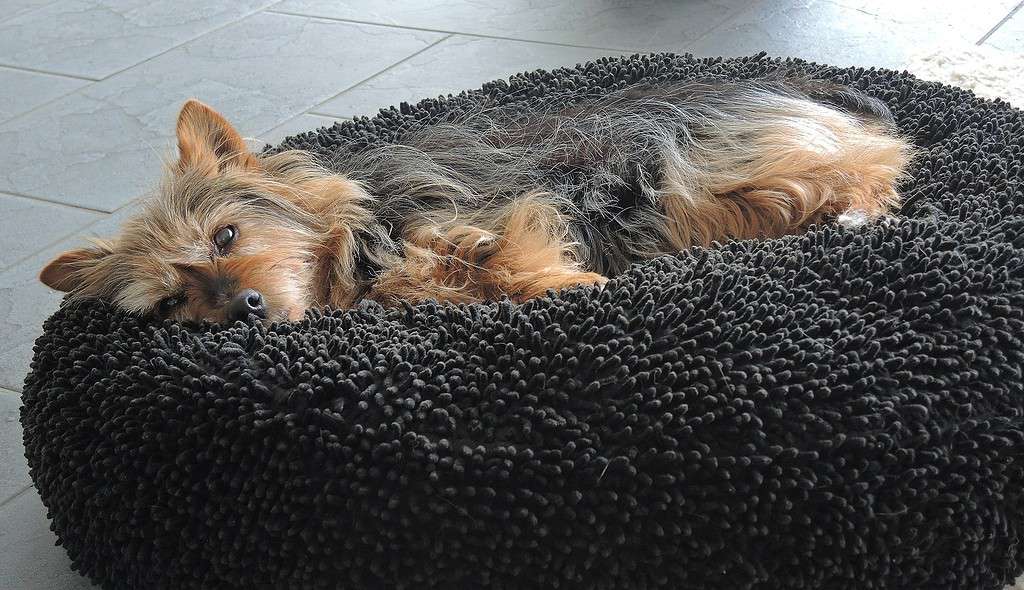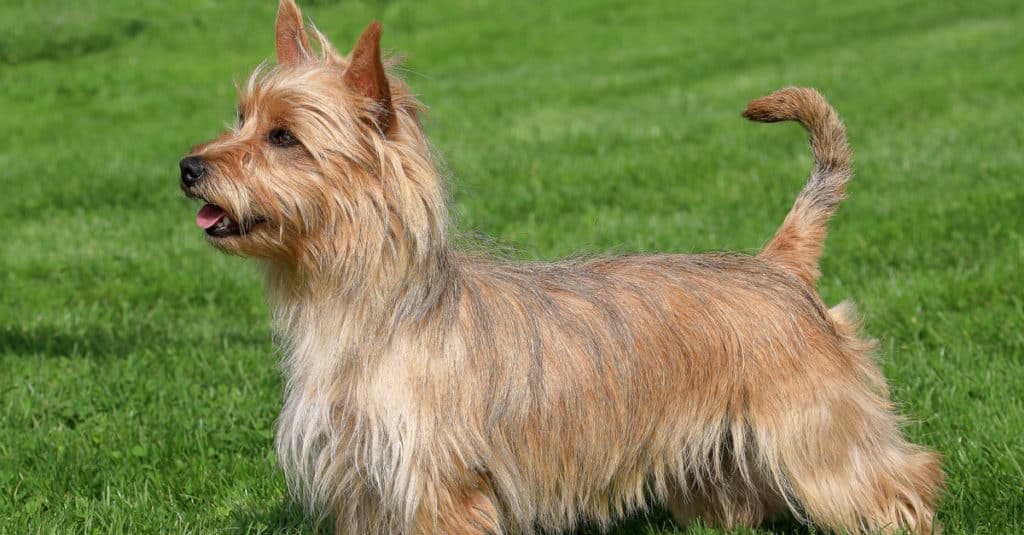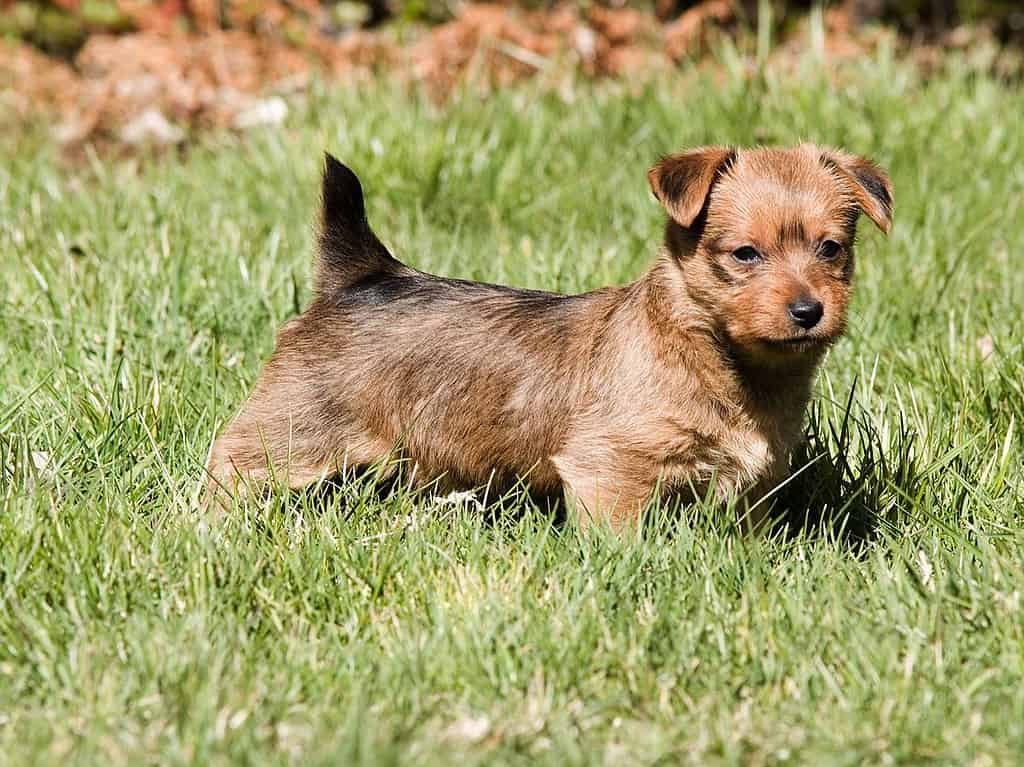Preparing to bring home an Australian terrier puppy? If so, you’re likely wondering what crucial info you need to know to raise a healthy, happy pup. In this guide, we’ll cover Australian terrier progression including puppy milestones, growth estimations, training tips, and more.
So, without further ado, let’s jump in!
Australian Terrier: Breed Summary
A small working breed, the Australian terrier was officially recognized by the AKC in 1960. In the mid-1800s, first, settlers of Tasmania, and then Australians, bred this small, hardy, and courageous terrier in response to needing canine assistance in controlling rodent and snake populations along waterfronts, in mines, and on sheep stations.
Likely, the ancestors of this tough little dog include a native rough-coated terrier of Australia, a close relative of the old Scotch dog of Britain, and precursors to the Skye terrier, Yorkshire terrier, and Dandie Dinmont terrier. In the mid-1900s, the Australian terrier made its way to the U.S. where farmers and families looking for a canine companion embraced the breed.
Standards and Attributes
While genetics isn’t the only contributing factor to the personality of an individual dog, it does typically have some influence. As such, you’ll often find that Australian terriers are a bit spunky, courageous, and energetic owing to the generations of breeding for these traits.
According to the AKC, the Australian terrier should be small, sturdy, of medium stockiness, and long in the body in proportion to their height. They should feature pricked ears, a keen expression, and a course, straight, and long outer coat. Accepted coat colors are blue and tan, solid sandy, and solid red.

The Australian terrier is an alert, intelligent, and hardy little dog.
©Lisjatina/Shutterstock.com
Australian Terrier Progression: Growth Chart
The below Australian terrier growth chart offers an estimation of what a healthy pup of this breed may weigh as they grow. Genetics and diet can cause variations in weight at maturity. To ensure that your Australian terrier pup is properly developing, it’s best to take them to periodic vet checkups.
| Age | Australian Terrier Weight |
|---|---|
| 2 months | 5-8 lbs |
| 3 months | 6.5-10 lbs |
| 4 months | 9-12.5 lbs |
| 5 months | 10.5-14.5 lbs |
| 6 months | 12.5-16 lbs |
| 7 months | 13.5-18 lbs |
| 8 months | 14-18.5 lbs |
| 9 months | 14.5-19 lbs |
| 10 months | 15-20 lbs |
When Will My Australian Terrier Stop Growing?
As a small breed dog, you can expect your Australian terrier pup to reach full physical maturity at about 10 months old. As opposed to large breed dogs that continue to develop until 18-24 months old, your Australian terrier will reach their full height and weight much quicker.
Depending on their activity level, this breed should eat about 1 to 1.5 cups of balanced dry food per day. Fresh water should always be available throughout their life.
Australian Terrier Progression: How Big Will My Australian Terrier Be When Fully Grown?
According to the AKC official standards, both male and female Australian terriers should weigh 15-20 pounds when fully grown. Male and female Australian terriers should also measure 10-11 inches tall at the withers. Again, diet and genetics can certainly cause a deviation from this standard.

You can expect your Australian terrier to weigh 15-20 pounds when fully grown.
©boitano/Shutterstock.com
When Should My Australian Terrier Be Spayed or Neutered?
The question of when to spay or neuter your dog needs to be considered at the breed and individual level. Spaying and neutering can offer some health benefits such as reducing or erasing the risk of cancers of the reproductive system. It also ensures that your pup does not have a litter, which only furthers the crisis that shelters and stray dogs face. In the U.S. alone, about 400,000 dogs are euthanized each year, overwhelmingly due to a lack of space.
However, spaying and neutering, especially under one year, can also cause an increased risk for some breeds of developing certain cancers, urinary tract issues, joint and bone conditions, and behavioral symptoms. This increased risk of health issues is typically more prominent in large and giant breed dogs.
One widescale study included a close relative of the Australian terrier– the Yorkshire terrier- and found no increased risks of cancers, urinary tract issues, or joint and bone conditions with spaying and neutering under a year. As such, it may be safe to alter your pup under a year old. However, it’s best to confirm the ideal time with a well-informed vet.
Australian Terrier Progression: When Should I Potty Train my Australian Terrier?
As with other puppies, you can begin potty training your Australian terrier at 8 weeks old. Consistency, patience, and good timing are crucial components of successful house training.
It’s important to know that your puppy can only hold their bladder for a small amount of time when they’re young. At 2 months old, your pup can typically only hold their bladder and bowels for about 2 hours. Placing them in a confined space in hopes it will make them uncomfortable to eliminate won’t change this time limit and it isn’t a kind way to treat your puppy. Instead, ensure that you’re offering your puppy bathroom breaks outside about every 2 hours and right after they’ve had meals or consumed lots of water.
At night, you can provide puppy pads in a corner of a spacious enclosure to give them a comfortable place to eliminate away from where they sleep and eat. If your Australian terrier pup has an accident, it’s critical to not punish or scold them as this can damage your relationship and cause your puppy to feel anxious about elimination. If you find that your puppy is having lots of accidents inside, you likely just need to increase how often you’re taking them out and increase praise and treats when they go outside.
When Should My Australian Terrier Stop Eating Puppy Food?
Since your Australian terrier is a small breed dog, you can begin transitioning them to adult food at 8-10 months of age. Make sure to confirm with your vet the best time to switch to adult food for your pup. Switching too early can negatively impact the development of your puppy’s joints and bones. As a puppy, your Australian terrier’s growth requires calorie and protein-rich foods. As their growth and metabolism slow down, they need to switch to adult food to support this change.
Australian Terrier Progression: When Will My Australian Terrier Start Losing Teeth?
At 12-14 weeks old, your puppy will start losing their set of 28 baby teeth. During this phase, their baby teeth fall out and are replaced by a set of 42 adult teeth. By 6 months of age, your Australian terrier should have a full set of permanent teeth.
You’ll find that they seek out items to chew during this process to soothe their sore gums. Their physical and mental well-being must provide your puppy with plenty of chew toys of various textures. You’ll also likely need to puppy-proof your house and limit access to certain areas to prevent your pup from chewing on valuable or unsafe items.
If you do see your Australian terrier pup chewing on an inappropriate item, rather than scolding and snatching the object away, simply trade them for an equally good or better, appropriate chew toy. By trading with your pup, you are teaching them that you are someone to whom they can safely give items since you won’t just take things away and leave them high and dry. Habitually taking without trading can lead to habitual resource guarding and can foment distrust, so make sure to consistently offer up the good stuff!
When Should I Start Training My Australian Terrier?
You can begin teaching your Australian terrier puppy cues and skills they’ll need to navigate our human world at about 8 weeks old. Especially when your puppy is so young, it’s crucial to keep training sessions short, easy to understand, and fun!
It’s also critical during this time to properly socialize your puppy. From 3-12 weeks of age is the crucial early socialization period in which your puppy’s brain is primed for learning and committing to memory of new experiences. If you’re adopting your puppy at 8 weeks, you’ll want to introduce them to one new thing from 8-12 weeks of age. These introductions to new sights, sounds, smells, tastes, and textures should be highly positive and not forced. Make sure to give your puppy time to process rather than just throwing them into a new environment or situation.
They also need about 18-20 hours of sleep during this time for their brain to properly develop, so make sure to provide plenty of opportunities for restful, restorative sleep.

Training sessions with your Australian terrier should be fun, positive experiences. Toys and treats are great positive reinforcers.
Australian Terrier Progression: What Cues Should I Teach My Australian Terrier First?
The first cues you teach your Australian terrier puppy should help strengthen your bond and set the foundation for your pup to navigate the world. Two of the most important cues to first teach any puppy are “come” and “drop it”.
Establishing a good recall is an excellent test of your relationship. While adding external rewards such as treats and toys are excellent ways to help positively reinforce this cue, you’ll want the primary reason for your pup to return to you when called to be an intrinsic motivation to be with you. Start by calling your puppy from just a few steps away and slowly increase the distance and distraction levels as you and your succeed.
By teaching your puppy to drop items upon request in exchange for a treat or toy you can help to ensure that your pup will willingly drop items that aren’t appropriate for them to chew or eat. Teaching “drop it” while trading for an item that is as good or better will also help prevent the development of resource-guarding behaviors.
When Will My Australian Terrier Calm Down?
People originally bred Australian terriers to be feisty, energetic, and courageous little hunting dogs. So, you can expect your pup will likely be quite energetic throughout their life. However, they should reach social maturity at about 24-36 months old, and at this point, you may notice a decrease in acutely energetic puppy-like behaviors.
Throughout your Australian terrier’s life, it’s crucial to provide mental, physical, and social enrichment to ensure the mental well-being of your pup. You may notice your pup exhibiting hyperactive behaviors if they don’t have enough access to species and breed-specific enrichment such as scent games, playing with toys and puzzles, social time with their preferred companions, exploring, food-based enrichment, etc.

Your Australian terrier will likely reach social maturity around 2-3 years old.
Australian Terrier Progression: Common Health Issues Your Australian Terrier Might Experience
The Australian terrier has an average lifespan of 12-14 years. There are a few health issues a dog of this breed faces an increased risk of developing. These conditions are as follows:
- Skin allergies
- Luxating patella (knee joint issue)
- Epilepsy
- Diabetes
- Legg-Calve-Perthes disease (condition of the thighbone)
If you notice in your Australian terrier sudden behavioral changes or more obvious clinical signs of a health issue it’s important to set up a vet appointment as soon as possible.
Picture of an Australian Terrier Puppy
Picture of an Australian Terrier at 6 Months

An adorable, inquisitive, 6-month-old Australian terrier.
©Sickre, CC BY-SA 4.0, via Wikimedia Commons – Original / License
Picture of a Fully Grown Australian Terrier

An adult, sandy-colored Australian terrier.
©Radomir Rezny/Shutterstock.com
The photo featured at the top of this post is © Lisjatina/Shutterstock.com
Ready to discover the top 10 cutest dog breeds in the entire world?
How about the fastest dogs, the largest dogs and those that are -- quite frankly -- just the kindest dogs on the planet? Each day, AZ Animals sends out lists just like this to our thousands of email subscribers. And the best part? It's FREE. Join today by entering your email below.
Thank you for reading! Have some feedback for us? Contact the AZ Animals editorial team.








